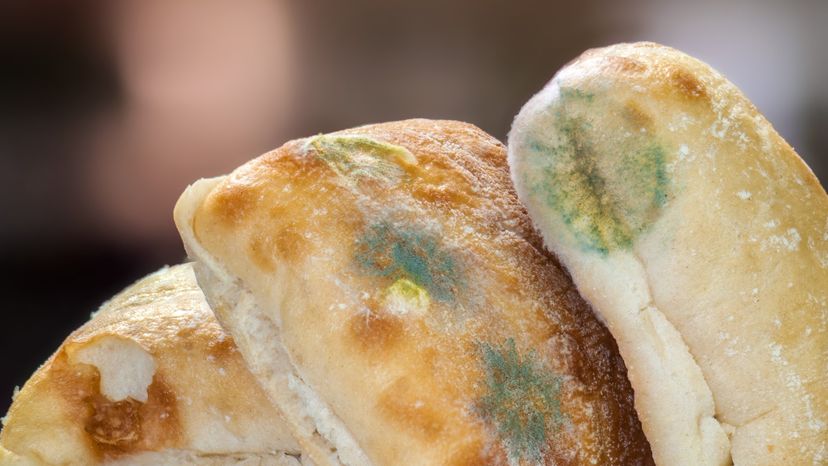By: Karen Kirkpatrick|Updated: Oct 11, 2023

It's 3:00 a.m. You're craving a peanut butter and jelly sandwich — or maybe a grilled cheese. You open the bread bag and — ugh! — the bread is blue with mold along one edge. As you're trying to decide whether to throw the bread away, you wonder, what happens if you eat moldy bread?
You remember that penicillin is made from mold [source: NLM]. That makes eating moldy bread okay, right? Think again. Here's the skinny on what might happen if you eat that moldy bread.
Advertisem*nt
Contents
- About Mold Spores
- Dangers of Mold
- Beyond Visible Mold
- How to Prevent Mold
About Mold Spores
Molds come from the same family as mushrooms. In fact, if you look at molds with a microscope, you'll see that they often look like little mushrooms: stalks with spores on the top.
These spores give molds their pretty colors — such as the blue-green shading lining your now-inedible bread [source: USDA].
Advertisem*nt
Dangers of Mold
While molds may be pretty, they can also be harmful. Many varieties — there are hundreds of thousands of molds — cause allergic reactions and respiratory illness. In some cases, molds produce mycotoxins, a poison that makes people, livestock and other animals sick.
And guess where one of the most notorious mycotoxins (aflatoxin) grows? That's right: on grains and nut crops, two things that make up many breads [source: USDA].
Advertisem*nt
Aflatoxin, a cancer-causing mold found around the world, is one of the most studied and monitored molds out there. But despite all the attention it gets, this mold has not been eradicated — though manufacturing plants across the globe are monitored to ensure levels of aflatoxin remain within acceptable limits [source: USDA].
Beyond Visible Mold
But back to the 3:00 a.m. piece of bread with the mold on one edge. What if you cut off the moldy part and just eat the rest? Surely that's okay, right? Wrong.
What you see on the edge of bread may be only the tip of the mold. From the stalks, mold can shoot roots down into the bread. These roots are where the mycotoxins like to grow. In addition, invisible bacteria that can also make you sick may be tagging along with the bread mold [source: Nelson].
Advertisem*nt
So, while your high school science teacher was right about penicillin being made from mold, it is not a good idea to try to get this bacteria-fighting agent from moldy bread.
The next time you're craving a PB&J or grilled cheese, check out your bread carefully. If there's mold present on the surface, you may be better off without a midnight snack.
Advertisem*nt
How to Prevent Mold
Here's how to keep bread fresh longer so you never have to worry about eating mold again.
Store bread in a breathable container, like a cloth bag, clean towel or paper bag and place it in a dry cupboard or bread box.
Advertisem*nt
If you can't finish a whole loaf within a few days, slice the bread and store the slices in the freezer, where it will keep for up to six months [source: Save the Food]. You can pop the frozen slices directly in the toaster later.
Frequently Answered Questions
Can you get penicillin from moldy bread?
You cannot get penicillin from moldy bread. Penicillin is produced by a type of mold, but it is not present in all types of mold.
Lots More Information
Related Articles
- How Organic Food Works
- 10 Foods that Contain Antibiotics
More Great Links
Sources
- National Library of Medicine (NLM). "How Did They Make Penicillin?" (May 17, 2015) https://www.nlm.nih.gov/exhibition/fromdnatobeer/exhibition-interactive/illustrations/penicillin-alternative.html
- Nelson, Carl. "Is It Safe to Eat That Moldy Bread?" Imagination Station. 2015. (May 17, 2015) http://imaginationstationtoledo.org/content/2011/08/is-it-safe-to-eat-that-moldy-bread/
- USDA Food Safety and Inspection Service. "Molds on Food: Are They Dangerous?" (April 30, 2015) http://www.fsis.usda.gov/wps/portal/fsis/topics/food-safety-education/get-answers/food-safety-fact-sheets/safe-food-handling/molds-on-food-are-they-dangerous_/
- Wright, Brierley. "4 Moldy Foods You Can Eat (Plus Which Foods to Toss)." Eating Well. May 18, 2012. (April 30, 2015) http://www.eatingwell.com/blogs/health_blog/4_moldy_foods_you_can_eat_plus_which_foods_to_toss
Cite This!
Please copy/paste the following text to properly cite this HowStuffWorks.com article:
Citation
More Awesome Stuff
Advertisem*nt
Advertisem*nt
Loading...
\n\n\t\t\t\t
`;t.byline_authors_html&&(e+=`By: ${t.byline_authors_html}`),t.byline_authors_html&&t.byline_date_html&&(e+="|"),t.byline_date_html&&(e+=t.byline_date_html);var i=t.body_html.replaceAll('"pt','"pt'+t.id+"_");return e+=`\n\t\t\t\t
\n\t\t\t\t
\n\n\t\t\t\t
${i=i.replaceAll("#pt","#pt"+t.id+"_")}
\n\n\t\t\t
`}(a);this.loadedDiv.innerHTML+=n,document.title=a.title+" | HowStuffWorks";let s="content-loaded-"+a.id,l=document.getElementById(s);l.dataset.contentId=a.id;let o=l.querySelectorAll(".lazyload");HSW.utilities.lazyLoadElements(o),HSW.ux.editorial.init({twitter:!0,facebook:!0,instagram:!0}),l.querySelectorAll(".toc a").forEach(t=>{t.addEventListener("click",t=>{t.preventDefault();let e=t.target.dataset.target,i=document.querySelector("a[name='"+e+"']");i?i.scrollIntoView({behavior:"auto"}):console.error("Unable to locate target with name "+e)})});try{if(userData.adsActive)if(HSW.utilities.isMobile()){l.querySelectorAll(".ad-mobinline").forEach(t=>{t.setAttribute("id","ad-wrap-mobinline"+r),t.childNodes[0].setAttribute("id","ad-div-mobinline"+r),void 0!==HSW.ads&&HSW.pq.add(()=>{HSW.ads.addNewUnits(["ad-div-mobinline"+r])},"ads"),r++})}else{let t=document.createElement("div");t.setAttribute("id","ad-after-"+e),t.classList.add("ad-inline","mb-8","bg-gray","w-max-full","h-min-90","text-center");let a=document.createElement("div");a.setAttribute("id","ad-div-inline"+i),t.appendChild(a),l.after(t),void 0!==HSW.ads&&HSW.pq.add(()=>{HSW.ads.addNewUnits(["ad-div-inline"+i])},"ads")}}catch(t){console.error(t)}if(window.setupSinglePageUX(l),history.pushState)try{history.pushState(null,a.title+" | HowStuffWorks",a.href)}catch(t){console.warn(t)}var c=[];a.taxonomy.forEach((t,e)=>{c[e]=t.title.toLowerCase()});var d=c.join("/"),h=[];a.authors.forEach((t,e)=>{h[e]=t.first_name.toLowerCase()+" "+t.last_name.toLowerCase()});var g=h.join(",");pageMetricsData.href=a.href,pageMetricsData.title=a.title,pageMetricsData.tax=d,pageMetricsData.aType=a.asset_type,pageMetricsData.cType=a.type+"-continuous",pageMetricsData.template=a.template,pageMetricsData.source=a.source,pageMetricsData.sponsor=a.sponsor,pageMetricsData.author=g,pageMetricsData.contentid=a.id,pageMetricsData.image=a.hero_image,pageMetricsData.page=0,pageMetricsData.pubDate=a.publish_date.slice(0,10),pageMetricsData.editDate=a.last_editorial_date.slice(0,10);const u=/[^\da-z_]/i;let p=HSW.utilities.isMobile()?"hsw_lite":"hsw";a.taxonomy.slice(1,3).forEach((t,e)=>{p+="|"+t.title.replace(u,"").toLowerCase()}),pageMetricsData.adUnit=p,Alpine.store("share",{title:pageMetricsData.title,url:pageMetricsData.href,image:pageMetricsData.image}),function(t,e){let i=t.href.split(".com/").pop();dataLayer.push({event:"virtual-page-view",virtualPageUrl:i,virtualPageTitle:document.title,pageNbr:0}),dataLayer.push({event:"raw-event-interactive",eventCategory:"page-interaction",eventAction:"continuous-load",eventLabel:"new-content",eventValue:e+1,virtualPageUrl:t.href})}(a,this.items.length);const m={...pageMetricsData};t.items.push(m);for(var f=document.getElementsByClassName("new-content-loaded"),v=0;v